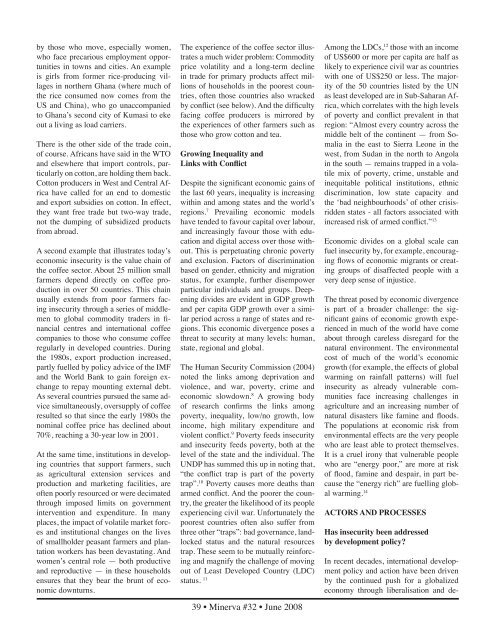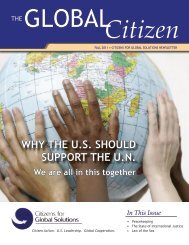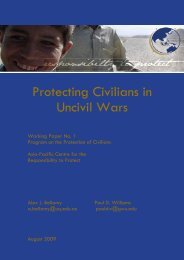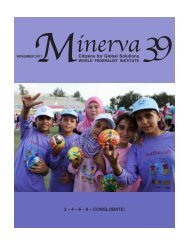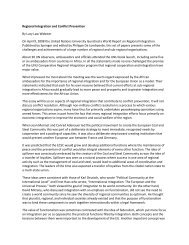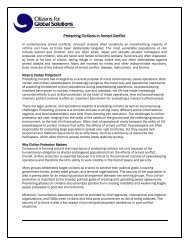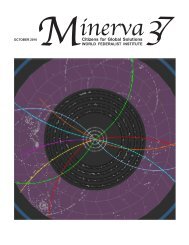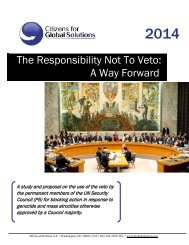Minerva, Spring 2008 (Volume 32) - Citizens for Global Solutions
Minerva, Spring 2008 (Volume 32) - Citizens for Global Solutions
Minerva, Spring 2008 (Volume 32) - Citizens for Global Solutions
You also want an ePaper? Increase the reach of your titles
YUMPU automatically turns print PDFs into web optimized ePapers that Google loves.
y those who move, especially women,<br />
who face precarious employment opportunities<br />
in towns and cities. An example<br />
is girls from <strong>for</strong>mer rice-producing villages<br />
in northern Ghana (where much of<br />
the rice consumed now comes from the<br />
US and China), who go unaccompanied<br />
to Ghana’s second city of Kumasi to eke<br />
out a living as load carriers.<br />
There is the other side of the trade coin,<br />
of course. Africans have said in the WTO<br />
and elsewhere that import controls, particularly<br />
on cotton, are holding them back.<br />
Cotton producers in West and Central Africa<br />
have called <strong>for</strong> an end to domestic<br />
and export subsidies on cotton. In effect,<br />
they want free trade but two-way trade,<br />
not the dumping of subsidized products<br />
from abroad.<br />
A second example that illustrates today’s<br />
economic insecurity is the value chain of<br />
the coffee sector. About 25 million small<br />
farmers depend directly on coffee production<br />
in over 50 countries. This chain<br />
usually extends from poor farmers facing<br />
insecurity through a series of middlemen<br />
to global commodity traders in financial<br />
centres and international coffee<br />
companies to those who consume coffee<br />
regularly in developed countries. During<br />
the 1980s, export production increased,<br />
partly fuelled by policy advice of the IMF<br />
and the World Bank to gain <strong>for</strong>eign exchange<br />
to repay mounting external debt.<br />
As several countries pursued the same advice<br />
simultaneously, oversupply of coffee<br />
resulted so that since the early 1980s the<br />
nominal coffee price has declined about<br />
70%, reaching a 30-year low in 2001.<br />
At the same time, institutions in developing<br />
countries that support farmers, such<br />
as agricultural extension services and<br />
production and marketing facilities, are<br />
often poorly resourced or were decimated<br />
through imposed limits on government<br />
intervention and expenditure. In many<br />
places, the impact of volatile market <strong>for</strong>ces<br />
and institutional changes on the lives<br />
of smallholder peasant farmers and plantation<br />
workers has been devastating. And<br />
women’s central role — both productive<br />
and reproductive — in these households<br />
ensures that they bear the brunt of economic<br />
downturns.<br />
The experience of the coffee sector illustrates<br />
a much wider problem: Commodity<br />
price volatility and a long-term decline<br />
in trade <strong>for</strong> primary products affect millions<br />
of households in the poorest countries,<br />
often those countries also wracked<br />
by conflict (see below). And the difficulty<br />
facing coffee producers is mirrored by<br />
the experiences of other farmers such as<br />
those who grow cotton and tea.<br />
Growing Inequality and<br />
Links with Conflict<br />
Despite the significant economic gains of<br />
the last 60 years, inequality is increasing<br />
within and among states and the world’s<br />
regions. 7 Prevailing economic models<br />
have tended to favour capital over labour,<br />
and increasingly favour those with education<br />
and digital access over those without.<br />
This is perpetuating chronic poverty<br />
and exclusion. Factors of discrimination<br />
based on gender, ethnicity and migration<br />
status, <strong>for</strong> example, further disempower<br />
particular individuals and groups. Deepening<br />
divides are evident in GDP growth<br />
and per capita GDP growth over a similar<br />
period across a range of states and regions.<br />
This economic divergence poses a<br />
threat to security at many levels: human,<br />
state, regional and global.<br />
The Human Security Commission (2004)<br />
noted the links among deprivation and<br />
violence, and war, poverty, crime and<br />
economic slowdown. 8 A growing body<br />
of research confirms the links among<br />
poverty, inequality, low/no growth, low<br />
income, high military expenditure and<br />
violent conflict. 9 Poverty feeds insecurity<br />
and insecurity feeds poverty, both at the<br />
level of the state and the individual. The<br />
UNDP has summed this up in noting that,<br />
“the conflict trap is part of the poverty<br />
trap”. 10 Poverty causes more deaths than<br />
armed conflict. And the poorer the country,<br />
the greater the likelihood of its people<br />
experiencing civil war. Un<strong>for</strong>tunately the<br />
poorest countries often also suffer from<br />
three other “traps”: bad governance, landlocked<br />
status and the natural resources<br />
trap. These seem to be mutually rein<strong>for</strong>cing<br />
and magnify the challenge of moving<br />
out of Least Developed Country (LDC)<br />
status. 11<br />
39 • <strong>Minerva</strong> #<strong>32</strong> • June <strong>2008</strong><br />
Among the LDCs, 12 those with an income<br />
of US$600 or more per capita are half as<br />
likely to experience civil war as countries<br />
with one of US$250 or less. The majority<br />
of the 50 countries listed by the UN<br />
as least developed are in Sub-Saharan Africa,<br />
which correlates with the high levels<br />
of poverty and conflict prevalent in that<br />
region: “Almost every country across the<br />
middle belt of the continent — from Somalia<br />
in the east to Sierra Leone in the<br />
west, from Sudan in the north to Angola<br />
in the south — remains trapped in a volatile<br />
mix of poverty, crime, unstable and<br />
inequitable political institutions, ethnic<br />
discrimination, low state capacity and<br />
the ‘bad neighbourhoods’ of other crisisridden<br />
states - all factors associated with<br />
increased risk of armed conflict.” 13<br />
Economic divides on a global scale can<br />
fuel insecurity by, <strong>for</strong> example, encouraging<br />
flows of economic migrants or creating<br />
groups of disaffected people with a<br />
very deep sense of injustice.<br />
The threat posed by economic divergence<br />
is part of a broader challenge: the significant<br />
gains of economic growth experienced<br />
in much of the world have come<br />
about through careless disregard <strong>for</strong> the<br />
natural environment. The environmental<br />
cost of much of the world’s economic<br />
growth (<strong>for</strong> example, the effects of global<br />
warming on rainfall patterns) will fuel<br />
insecurity as already vulnerable communities<br />
face increasing challenges in<br />
agriculture and an increasing number of<br />
natural disasters like famine and floods.<br />
The populations at economic risk from<br />
environmental effects are the very people<br />
who are least able to protect themselves.<br />
It is a cruel irony that vulnerable people<br />
who are “energy poor,” are more at risk<br />
of flood, famine and despair, in part because<br />
the “energy rich” are fuelling global<br />
warming. 14<br />
ACTORS AND PROCESSES<br />
Has insecurity been addressed<br />
by development policy?<br />
In recent decades, international development<br />
policy and action have been driven<br />
by the continued push <strong>for</strong> a globalized<br />
economy through liberalisation and de-


